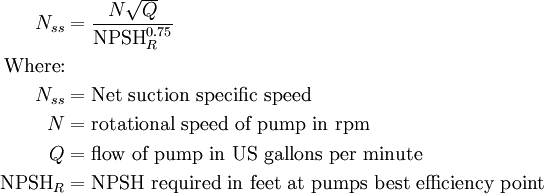To use all functions of this page, please activate cookies in your browser.
my.chemeurope.com
With an accout for my.chemeurope.com you can always see everything at a glance – and you can configure your own website and individual newsletter.
- My watch list
- My saved searches
- My saved topics
- My newsletter
Specific SpeedThe net suction specific speed is a dimensionless number defined by centrifugal and axial pumps' inherent physical characteristics and operating point [1] . It is one of a number of factors used in selecting a pump for use and is mainly used to see if there will be problems with cavitation during the pumps operation on the suction side [2] . The net suction specific speed of a pump will define the range of operation in which a pump will experience stable operation [3] . The higher the net suction specific speed, then the smaller the range of stable operation. The envelope of stable operation is defined in terms of the best efficiency point of the pump. Product highlightThe Net suction specific speed is defined as[4]:
References
See alsoCategories: Fluid dynamics | Pumps |
| This article is licensed under the GNU Free Documentation License. It uses material from the Wikipedia article "Specific_Speed". A list of authors is available in Wikipedia. |








